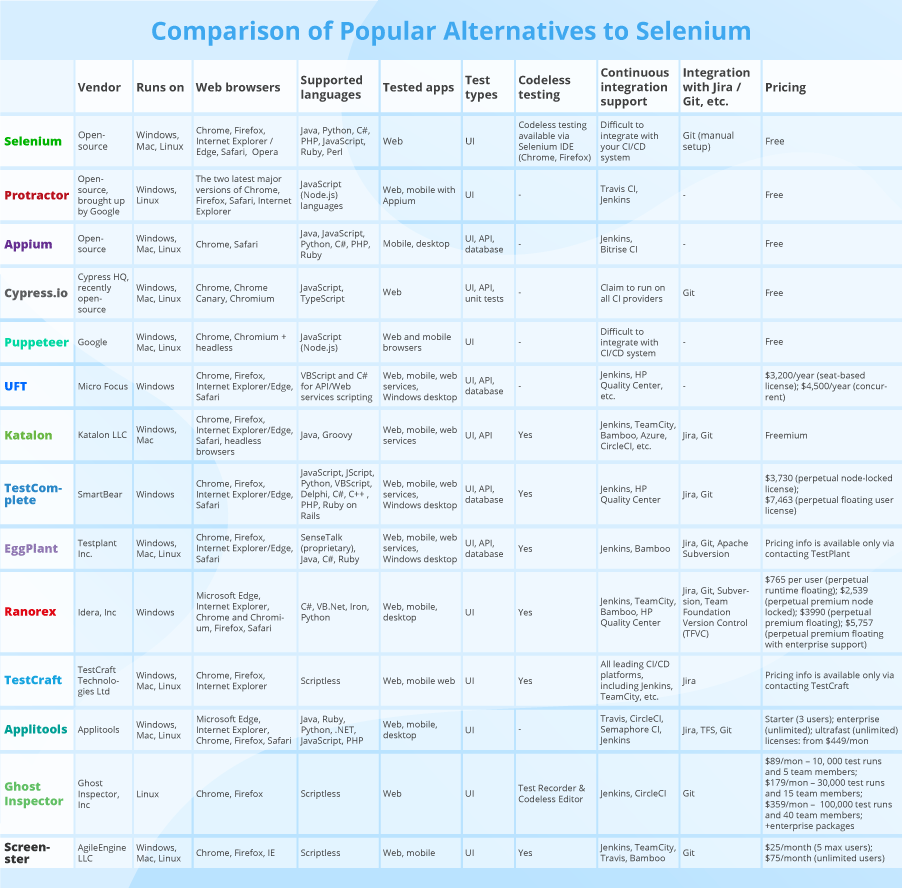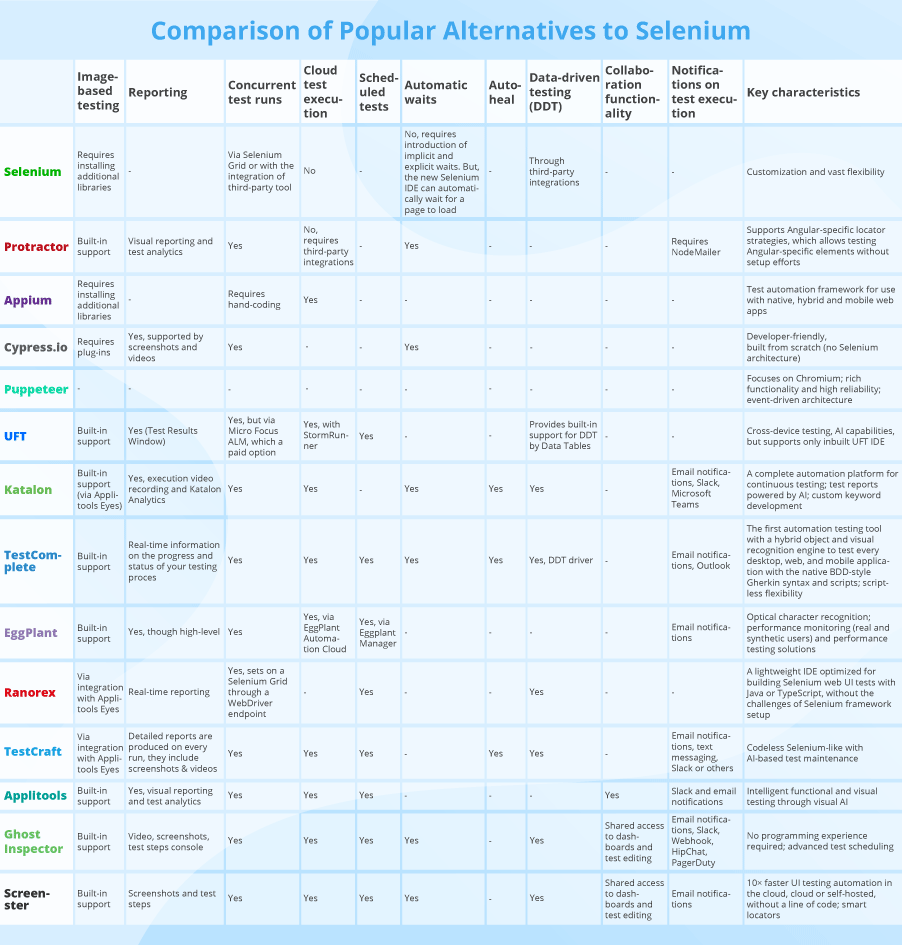Evaluating 2025 Selenium Competitors: Is There a Good Alternative?
Editor’s note: Bringing on the experience from dozens of Selenium-based test automation projects, ScienceSoft’s test automation team reveals the major Selenium weaknesses and assesses the most valid Selenium alternatives. And if you’d like to get personalized recommendations regarding a particular test automation project, don’t hesitate to contact our test automation engineers directly and discuss the best fit for your needs.
Designed to support a wide range of browsers and programming languages, Selenium is one of the most widely used tools for automated web UI test development and execution. Selenium is also one of the core technologies in our QA services. However, Selenium has a number of inconveniences. Is the market of test automation tools ready to offer a better alternative to achieve continuous testing?
Basing on our experience in test automation, let’s consider inconvenient specifics of the Selenium environment for automated testing and explore some of the less widespread alternatives for automated testing tools that claim to overcome these inconveniences and offer more sophisticated testing capabilities.

Automated testing of mobile and desktop applications is not available
Modern web-based software usually has a complementing mobile app, and a desktop version is present sometimes. Thus, the use of a single agile testing tool across the web and mobile environments is more convenient than employing separate tools – this reduces the testing time through test reuse and allows reusing the existing testing skills.
By default, Selenium allows only desktop browsers testing. To use Selenium for mobile testing, you need to integrate a third-party tool. In our test automation practice we mostly apply Appium, which reuses Selenium core libraries, so those familiar with Selenium testing can easily write both tests. Configuring an application under test (AUT) to run on Appium has a lot in common with Selenium, and it’s even possible to reuse Selenium web application tests there. Appium works for mobile web apps, hybrid and native (both Android and iOS) apps. With regard to desktop software, Appium also supports Mac (though, yet not stable) and Windows desktop testing.
By comparison, such Selenium alternatives as UFT, Ranorex, and TestComplete have in-built capabilities to cover testing for web, mobile, and desktop software.
No API testing
Some of an application’s functionality can be checked via direct requests to the application’s business logic or external web services (API testing). Such tests are more stable, faster to run and can be started earlier in the development process. Thus, the combination of API and UI tests is almost a must in our agile development processes, as it reduces the testing time and helps detect problems when the costs and efforts to fix them are lower.
For small agile teams, which integrate testing at UI and API levels, the usage of a single test automation tool can help with streamlining the testing process and reusing the existing knowledge.
Selenium is focused on web testing via UI only. Generally, testers working with Selenium need to employ a separate test automation tool to develop and execute API test scripts, i.e., JMeter, Postman or SoapUI.
Luckily, the modern market offers a legion of alternative test automation tools that run and verify both UI and API tests. Among them are UFT, Katalon, TestComplete, and Cypress.io.
No in-built support of image-based testing
Image-based testing is growing in popularity as a way to verify that users see exactly what they are to see. Checking the size, layout, and color scheme of visual elements, verifying whether correct images and icons are displayed, and testing the charts and dashboards become complicated when executed through functional test scripts, especially in the context of frequent UI changes. By simply taking a screenshot of “what a user sees” and comparing it with a reference template, visual testing makes the UI testing process much easier and faster.
Selenium doesn’t support image-based testing by default and requires the integration of additional libraries or tools (e.g., Applitools) to allow that.
Among Selenium alternatives, UFT and TestComplete have in-built support of image-based testing and base on the pixel-by-pixel comparison. However, this comparison technique is of little use when an application employs, for example, blinking input cursors, font smoothing, changing UI themes, and dynamic news and ad content.
AI-based testing is believed to be the next step in visual testing. The AI-based alternative to Selenium like Eggplant AI and Applitools apply specific computer vision algorithms to check similarity between the objects under test rather than testing the exact pixel match.
A special case is Screenster.io, an all-in-one cloud-based platform for visual regression testing. Though not AI-driven, Screenster.io offers algorithms that can detect new, deleted or updated content, or, on the contrary, ignore small changes caused by rendering. Screenster.io also enables testing in the cloud, offers automatic handling of dynamic content and self-healing locators for all UI elements, which significantly simplifies test maintenance.
No test results reporting
Reporting is one of the core stages in the test automation pipeline where test scripts are executed unattended. To quickly understand and explain the issue to developers, a test automation engineer should get a detailed description of problems in code that tests revealed.
Selenium doesn’t have in-built report generation capabilities. Our testers usually integrate dedicated third-party tools like Allure, a lightweight and open-source test automation tool. It delivers a clear representation of test results satisfying both technical and non-technical users and has a test analytics function.
Unlike Selenium, most alternative test automation tools (Protractor, TestComplete, TestCraft, Cypress, etc.) have pretty decent reporting capabilities. For example, Katalon by default generates neat reports with details supported by logs, screenshots and videos that can be easily exported into CSV, HTML and PDF files. In addition, Katalon provides instant intuitive dashboards and graphs to see how the execution of the test code goes.
Complicated dynamic content testing
Dynamic content is represented by UI components that adaptively change according to a user’s behavior, preferences, location, etc. During web application testing, dynamic content is one of the main problems even for the most sophisticated testing teams as testing code should wait till all the required elements are updated before going on with test execution. Otherwise, testers will get overloaded with faulty tests and “false” exceptions because the test script won’t be able to find the needed web element.
To manage wait time, Selenium requires a tedious manual setup of explicit, implicit or fluent wait timeouts. There are also additional third party Selenium libraries that support more advanced waits to automatically retry the query until either element is found or the set time is reached.
As for alternative test automation tools, Protractor (for Angular.js), Cypress, or Screenster, for example, can automatically wait for async operations to finish.
Troublesome installation
Selenium is basically a set of APIs. When setting up and configuring the Selenium testing process, you need to go through technical guidelines for the APIs, set up an IDE, download and configure bindings for the preferred programming languages. Moreover, as many important features (reporting, cross-browser testing, etc.) are not integrated to Selenium by default, you may have to go through manual integrations of plugins and third-party tools. And the integration process requires basic programming knowledge and several days to complete. Such a modular approach is typical for open-source tools in any area, but long and costly processes are often not reasonable for small projects.
Built as a bundle, all commercial alternatives to Selenium, such as Katalon, Ranorex, TestComplete strive to minimize setup and configuration efforts. You just download and install them on your computer. However, there may be some limitations resulting from that, e.g. lack of flexibility to add tools needed for a particular project or for test process improvement being implemented.
No dedicated technical support
As Selenium is an open-source test automation tool, there is no vendor support for fast problem-solving, and users can rely only on helping communities and forums.
Commercial alternatives actively support their users with dedicated support staff and customer support portals.
Comparison in tables
We’ve summarized the info about all mentioned tools for automated testing in 2 comprehensive tables for you to take an in-depth look at key parameters and make a final decision on your test automation solution, given your specific needs and preferences.


Download PDF file: Comparison of Popular Selenium Alternatives
Final takeaway
Although the market abounds in-browser testing tools that exceed Selenium in individual parameters, still Selenium is one of the most popular test automation platforms through its open-source character, universality, flexibility and huge community support. At ScienceSoft, we use Selenium in around 60% of our automated testing projects. ScienceSoft’s test automation team can help you build optimal Selenium-based automation, minimizing its bottlenecks and using Selenium’s potential to the fullest. We will also help organize automated testing, align it with development and integrate it to CI/CD.

